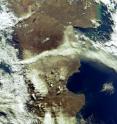Chilean volcano captured blasting ash
Chile’s Chaiten Volcano is shown spewing ash and smoke (centre left of image) into the air for hundreds of km over Argentina’s Patagonia Plateau in this Envisat image acquired on 5 May 2008. The 1000 m-high volcano had been dormant for thousands of years before erupting on 2 May, causing the evacuation of thousands. Chaiten Volcano is located in southern Chile 10 km northeast of the town of Chaiten on the Gulf of Corcovado.
Envisat’s Medium Resolution Imaging Spectrometer (MERIS) instrument processed this image at a resolution of 1200 m.
Satellite data can be used to detect the slight signs of change that may foretell an eruption. Once an eruption begins, optical and radar instruments can capture the lava flows, mudslides, ground fissures and earthquakes.
Atmospheric sensors onboard satellites can also identify the gases and aerosols released by the eruption, as well as quantify their wider environmental impact.
To boost the use of Earth Observation (EO) data at volcanic observatories, ESA has started to monitor volcanoes worldwide within the Agency’s Data User Element programme.
The Globvolcano project, started in early 2007, will define, implement and validate information services to support volcanological observatories in their daily work by integration of EO data, with emphasis on observation and early warning.
Source: European Space Agency
Articles on the same topic
- Chile's Chaiten volcano one of scores of active volcanoes in region, says CU-Boulder professorWed, 7 May 2008, 13:28:39 UTC
Other sources
- Livestock, Pets Left Behind As Chile Volcano Fears Loomfrom National GeographicFri, 9 May 2008, 20:21:03 UTC
- Chile gives volcano holdouts ultimatum to fleefrom Reuters:ScienceFri, 9 May 2008, 1:35:05 UTC
- Chilean volcano captured blasting ashfrom PhysorgThu, 8 May 2008, 15:42:09 UTC
- Chilean Volcano Captured Blasting Ashfrom Science DailyThu, 8 May 2008, 14:35:32 UTC
- Chilean volcano captured blasting ashfrom European Space AgencyThu, 8 May 2008, 8:56:31 UTC
- Military evacuated as Chile volcano eruption flaresfrom Reuters:ScienceThu, 8 May 2008, 8:56:20 UTC
- Chaiten volcano erupts in Chilefrom LA Times - ScienceWed, 7 May 2008, 16:28:15 UTC
- Chile's Chaiten volcano one of scores of active volcanoes in regionfrom PhysorgWed, 7 May 2008, 15:21:24 UTC
- Chile's Chaiten Volcano One Of Scores Of Active Volcanoes In Regionfrom Science DailyWed, 7 May 2008, 15:21:09 UTC
- PHOTOS: Chile Volcano Erupts With Ash, Lava, Lightningfrom National GeographicWed, 7 May 2008, 12:42:13 UTC
- Emergency evacuation as Chile volcano spits lavafrom Reuters:ScienceWed, 7 May 2008, 0:42:06 UTC
- Volcano Erupts in Chile; Spews Ash 12 Miles Upfrom National GeographicTue, 6 May 2008, 20:56:15 UTC
- Chile Volcano Eruption Sends Residents Fleeing, Causes One Death [News]from Scientific AmericanTue, 6 May 2008, 17:14:06 UTC
- Volcano in Chile spews lava and blasts ash 12 miles into skyfrom AP ScienceTue, 6 May 2008, 15:21:14 UTC
- New evacuation as Chile volcano spews lava: reportfrom Reuters:ScienceTue, 6 May 2008, 13:35:13 UTC
- Erupting volcano prompts new evacuation in Chilefrom Reuters:ScienceMon, 5 May 2008, 18:21:11 UTC
- Thousands evacuated as Chile volcano spews ashfrom Reuters:ScienceSun, 4 May 2008, 0:42:04 UTC
- Chilean volcano town nearly desertedfrom AP ScienceSat, 3 May 2008, 22:21:03 UTC
- Rumbling volcano forces evacuation of southern Chilean townfrom PhysorgSat, 3 May 2008, 21:07:06 UTC
- Thousands evacuated as Chile volcano spews ashfrom Reuters:ScienceSat, 3 May 2008, 16:56:04 UTC
- Chilean volcano belches ash, forces evacuationfrom Reuters:ScienceFri, 2 May 2008, 17:35:04 UTC
